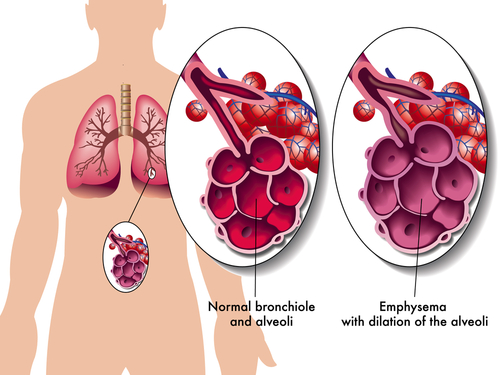
In a study of mice, researchers at Johns Hopkins have identified a new molecular pathway involved in the growth of tiny air sacs called alveoli that are crucial for breathing. The scientists said their experiments may lead to the first successful treatments to regrow the air sacs in people who suffer from diseases such as emphysema in which the air sacs have been destroyed by years of smoking. The work may also suggest new therapy for premature infants born before their lungs are fully developed.
“One of the most daunting challenges we face as physicians is helping patients with chronic obstructive pulmonary disease, such as emphysema, who have lost alveoli that are so crucial for lung function,” said Enid Neptune, associate professor of pulmonary and critical care medicine at the Johns Hopkins University School of Medicine. “Once those tiny air sacs are destroyed, there are no effective treatments to bring them back.”
Neptune is the senior author of a study described in an article in PLOS Genetics, in which the researchers used hepatocyte growth factor (HGF) to regrow alveoli and restore lung structure in mice genetically engineered to develop a human-like form of emphysema. Theirs is believed to be the first study using HGF in mice with established emphysema.
Growth factors, such as HGF, have been used to promote wound healing. Neptune said previous studies had shown that HGF had a role in the functioning of alveoli, which enable lungs to exchange oxygen and carbon dioxide and send oxygen into the bloodstream to nourish organs throughout the body. Reduction in the number or quality of the sacs seriously compromises breathing.
Even though they cannot be seen by the naked eye, tiny, spherical alveoli are covered with thin walls and have a blood supply. The researchers conducted experiments in mice with a genetically induced form of emphysema to see if HGF could stimulate the formation of alveoli.
One experiment involved adult mice with genetically induced emphysema. Half of the mice received HGF, delivered under the skin using a special pump for two weeks. The other half of the group received a placebo – not the HGF. Another group of mice with healthy lungs, the “control” group, was divided in half to receive either HGF or a placebo.
“We found that the mice with emphysema, when given the HGF, developed a 17 percent improvement in the size of their air sacs compared to placebo-treated mice, consistent with improved lung structure and function. The HGF also was protective, preventing destruction of the alveoli by reducing the oxidative stress that contributes to lung injury,” said Neptune. “In essence, the HGF was able to block a major enemy of the functioning alveoli.”
In addition, the healthy mice that received HGF showed no difference in alveolar size. The mice with emphysema that were treated with a placebo did not show any improvement.
The researchers then wanted to see the effect of impaired HGF activity in young mice whose lungs were still forming. They created a mouse in which the HGF receptor, known as MET, was removed from the cells lining the alveoli. “Our idea was if HGF was performing this important role in alveoli formation, if we knocked out its receptor, known as MET, we should see damage to the alveoli,” said Neptune.
As predicted, the air sacs in the developing mice without the HGF receptor did not form correctly. Also, the blood vessels serving the alveoli were reduced and there was an increase in both oxidative stress and inflammation. The researchers concluded that developing alveoli require both HGF and MET signaling in order to form normally.
“Our research is an important demonstration that a growth factor can be used as a drug for emphysema,” Neptune said. “However, since HGF reduces cell death and promotes cell proliferation, we would have to be cautious about translating it to the smoking population where there’s a higher risk of lung cancer.” she adds. Neptune and others are pursuing research to be able to selectively activate the therapeutic and not the malignancy-inducing components of HGF signaling.
Emphysema is a form of chronic obstructive pulmonary disease (COPD), which is the third-leading cause of death in the United States. An estimated 30 million Americans have COPD and about 60,000 people die from it each year. In addition to smoking, occupational exposure to harmful dust, fumes and smoke can also cause COPD.
The title of the article is “Hepatocyte Growth Factor, a Determinant of Airspace Homeostasis in the Murine Lung.”
The study was funded by Neptune’s NIH RO1 grant# 1R01HL085312 and also by a March of Dimes Basil O’Connor Award to Neptune.
Other authors are: Carla Calvi, Megan Podowski, Armando Lopez-Mercado, Shana Metzger, Kaori Misono, Alla Malinina, Dustin Dikeman, Hataya Poonyagariyon, Leslie Ynalvez, Roshanak Derakhshandeh, Ann Le, Mark Merchant and Ralph Schwall (deceased).
Source: Johns Hopkins Hospital
Thanks for installing the Bottom of every post plugin by Corey Salzano. Contact me if you need custom WordPress plugins or website design.

